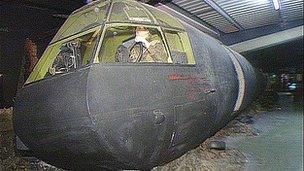'Disposable' WWII glider cockpit re-created in Gloucestershire
- Published

The glider seen here at the D-Day Museum was never designed to "come back"
Part of a World War II glider is being built by enthusiasts in Gloucestershire on the site it was originally made.
The cockpit of a Horsa glider is being re-created as part of an exhibition for the new Jet Age Museum at Staverton.
Made by cabinet makers, the wooden giants, with a 88ft (27m) wingspan, were designed to carry large numbers of troops and supplies to an enemy target.
Co-ordinator Trevor Davis said: "They were disposable and never designed to come back that's why there are so few."
Manufactured by 30 different companies, including Gloucestershire based HH Martyn, the fragile aircraft were designed to glide into a drop zone delivering troops and supplies.
Assembled at Minchinhampton and Little Rissington in the county, they had the advantage of landing soldiers and supplies together, rather than scattered by parachute and allowed troops to be deployed without parachute training.
'Broke on landing'
"They delivered not only troops but armaments and vehicles in a very economical way when resources were very difficult," said Mr Davis.
"I've heard stories of jeeps, artillery pieces as well as 15 or 16 troops as well as two pilots.

Horsas helped to land 14,000 British and American troops as part of Operation Varsity
"But they [the gliders] were only planned to go once and most broke up on landing".
They were most famously used in Operation Market Garden, the assault on Arnhem in September 1944. The Glider Pilot Regiment suffered 90% casualties during the battle.
Operation Varsity in March 1945 was more successful, with Horsas helping to land 14,000 British and American troops on the east bank of the River Rhine.
Ken Ploughman, a former RAF pilot who flew in Operation Varsity, said he "thought more about what the troops were thinking" behind him than the risks.
"I never thought about it and we didn't have parachutes either - I mean it was a job and our main concern was to get them into operation," he said.
'Saved my life'
He also said the Gloucestershire built cockpit had saved his life.
"We'd landed on the banks of a little stream - struck it - had to because I had no choice as to where we were landing and the nose broke off with us in it," he said.
"It remained in one piece and rolled into the field - well it saved my life, it really saved my life."
The Horsa glider cockpit will be on display at the Jet Age Museum, which is due to open next year.